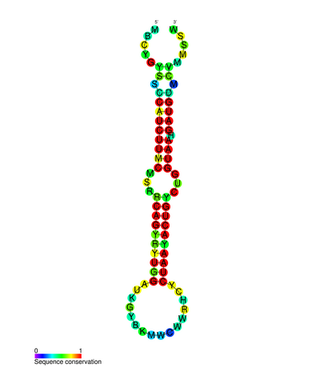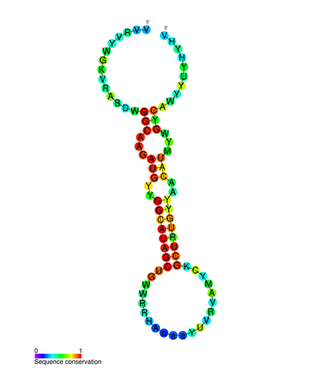Identified oncomirs
The OncomiR-1 line
The OncomiR-1 cluster of miRNA's is one of the best characterized set of mammalian miRNA oncogenes. The oncomir-1 gene, also known as mir-17-92, encodes a single mRNA transcript that folds into six stem loops. Several cancer-associated oncomirs are generated from these stem loops, including miR-17, miR-18, miR-19a, miR-20, miR-19b, and miR-92. It has been shown that miRNA's from the OncomiR-1 line inhibit cell death, thus increased expression of oncomir-1 leads to the development of tumors. The oncomir-1 products inhibit expression of the transcription factor E2F1, which may impact apoptosis via the ARF-p53 pathway. It is predicted that there are several hundred target mRNAs for each miRNA, and therefore likely many additional targets for the OncomiR-1 line [1]
OncomiR Resources and Databases
There are a few online resources and databases for collecting and annotating the oncogenic and tumor-suppressive miRNAs:
OncoMir Cancer Database Online database to access TCGA miRNA sequencing based expression data from over 10,000 tumor and normal tissues. OncomiRDB: a database for the experimentally verified oncogenic and tumor-suppressive microRNAs.
miRCancer: microRNA Cancer Association Database
HMDD: Human microRNA Disease Database
PhenomiR: a knowledgebase for microRNA expression in diseases and biological processes
Oncomir A collection of microRNA expression databases
Characteristics and mechanisms of some well defined oncomirs
miR-17
MicroRNA-17, or miR-17, is a member of the OncomiR-1 family and one of the first miRNA to be identified as an oncogene. miR-17 has been confirmed to target the cell cycle transcription factor E2F1, a protein that not only promotes cell growth but also death. [11]
miR-19
MicroRNA-19, or miR-19, is a member of the OncomiR-1 family, and consists of three sub classifications in both humans and mice: mir-19a, mir-19b1 and miR-19b2. miR-19 has been shown to downregulate phosphatase and tensin homolog (PTEN) effectively increasing activity of the cellular survival-promoting signal pathway PI3K-Akt. [11]
miR-21

MicroRNA-21, or miR-21, a specific oncomir, becomes more abundant in human cancer. MicroRNA-21 elevation has been found in a wide variety of cancers, including glioblastoma, breast, colorectal, lung, pancreas, skin, liver, gastric, cervical, thyroid, and various lymphatic and hematopoietic cancers. [12] It has been found to down-regulate the tumor suppressor PDCD4, thus aiding in the cancer's invasion, intravasation and metastasis. [13]
miR-155
MicroRNA-155, or miR-155, is a commonly over-expressed oncomir in human cancers. In human breast cancer, it has been identified to target the gene which encodes for a protein called suppressor of cytokine signaling 1 (SOCS1). Recent research suggests that miR-155 negatively regulates SOCS1, but may be a feasible target in breast cancer therapy. [14]
miR-569

A strong association has been identified between miR-569 and 3q26.2, a chromosomal locus that is amplified in some breast cancers. Altered expression of the miR-569 gene has been demonstrated to affect growth and proliferation of breast epithelial cells. Ectopic expression of miR-569 resulted in tumor cell proliferation and metastasis. This occurs through miR-569 inhibition of TP53INP1, a tumor suppressor gene. In comparison to normal tissues and less malignant tumors, TP53INP1 occurs at lower levels in more invasive cancers, presumably in part due to the role played by miR-569. [15]











